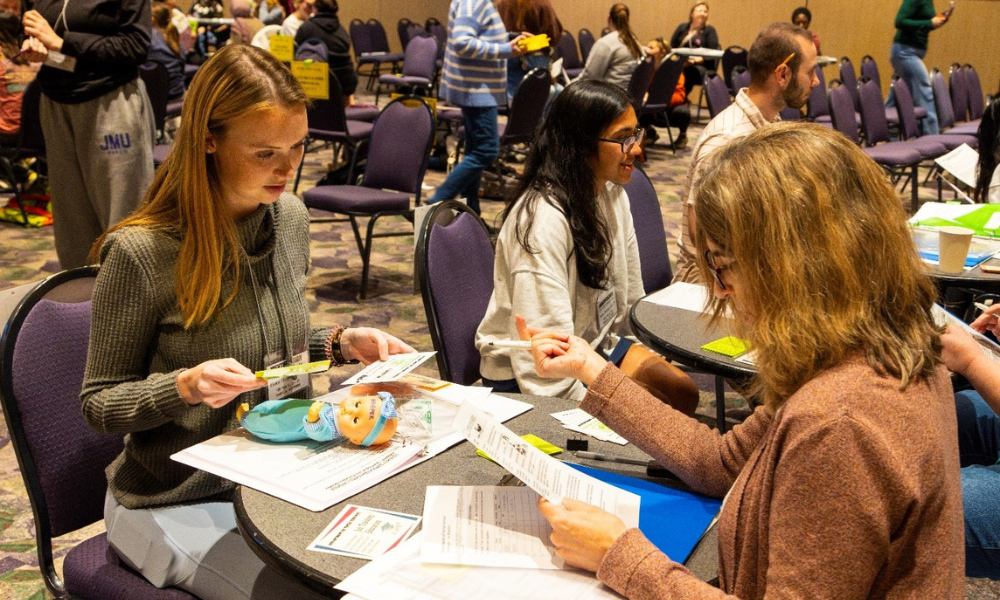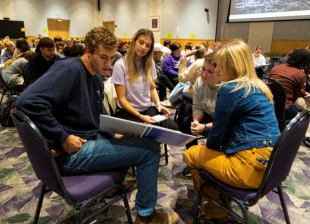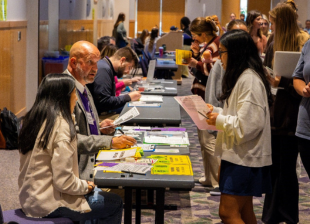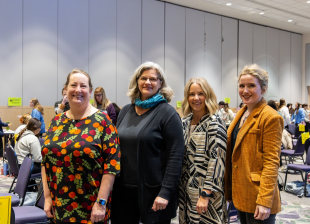Research Shapes Student-Centered Poverty Simulation
News
SUMMARY: The Poverty Simulation, one of CHBS's most vital interprofessional and interdisciplinary learning tools, benefits students by being informed by, as well as generating, research.
Note: responses have been edited for length and/or clarity.
For over twenty years, students in the College of Health and Behavioral Studies have learned about the realities faced by low-income families via the Life in the State of Poverty simulation, an educational experience developed by the Reform Organization of Welfare Education Association of Missouri (ROWL). Hosted by the Institute for Innovation in Health and Human Services (IIHHS), JMU’s version of the program was initially shepherded by Emily Akerson and other faculty, though the purpose has never wavered—it encourages students from all CHBS’s academic disciplines to recognize the importance of interdisciplinary and interprofessional collaboration when addressing critical issues like poverty. For the past three semesters, students and faculty from Bridgewater College have also joined the training under the guidance of Cristin Sprenger.

needs for the "month"
In the simulation, students function as an under-resourced family that must establish and maintain shelter and necessities for one “month,” which consists of four 15-minute “weeks.” Each family unit includes participants from different academic programs, including Communication Sciences and Disorders, Dietetics, Health Sciences, Health Services Administration, Kinesiology, Nursing, Psychology and Social Work, and the month-long simulation process is designed to expose students to “some of the confusion, defeat, frustration, exhaustion and despair that low-income families experience,” according to Hart.
Relying on thirty faculty, staff and graduate students per session, each simulation has JMU volunteers take on the roles of service provider or community agency staff member, (e.g., teacher, social worker, banker, etc.). By portraying these roles, volunteers are immersed in the learning process, just like student participants.

assume the roles of community agencies
and businesses in the simulation
REDI caught up with the program’s current co-coordinators: Vesna Hart, Associate Director of Interprofessional and Interdisciplinary Education and Programs at IIHHS, Natasha Miller, Assistant Professor of Social Work, and Callie Bradley, Assistant Professor of Nursing, asking them what makes this educational exercise so vital for students, as well as what research informs and is produced by the process.
Why is it critical for future health clinicians and educators to have insight into poverty and the emotions people may feel while struggling with financial insecurity?
Miller: “Health clinicians and educators need to be empowered with [accurate] perspectives and realize how harmful it is for them to harbor false narratives and stereotypes of who experiences financial insecurity and why.”
Bradley: “It is critical for future health professionals and educators to have insight into poverty and the emotions people may feel while struggling with financial insecurity because poverty doesn’t just affect an individual’s financial situation—it has profound effects on their physical, mental, and social well-being. Poverty is one of the most significant social determinants of health (SDOH).”
Hart: “…the Poverty Simulation provides an opportunity for students to start thinking about ways of collaborating to address poverty. No profession or discipline can solve the issue of poverty by themselves. Collaboration and multiple disciplinary perspectives are required to address the complexity of poverty.”
Running over the course of multiple days in both the fall and spring semesters, the poverty simulation is part of the college’s Interprofessional and Interdisciplinary Education (IPE and IDE) program; why prioritize interdisciplinary learning focused on simulations and self-knowledge?
Bradley: “Prioritizing interdisciplinary learning is essential to preparing future health professionals and educators for the complexities they will face in practice…By experiencing the challenges of poverty and engaging in self-reflection, students can better appreciate the importance of working together across professions to address the root causes of health disparities and provide holistic, patient-centered care.”
Miller: “Simulation experiences have the power of putting participants in touch with social issues, like poverty, that might be obscure to them—thereby building personal awareness and sensitivity to a topic that they might otherwise have overlooked.”
What scholarship informs the poverty simulation and the IPE/IDE program, and how do we see that research shaping educational objectives and outcomes?
Hart: “Existing research focused on the outcomes of the Poverty Simulation has found that attitudes, knowledge, and understanding of poverty are impacted by a poverty simulation, with statistical changes noted in many domains: increased empathy, reduced judgment of low-income people, increased awareness of the prevalence of poverty, improved understanding of how poverty impacts health inequities, increased ability to understand and identify with the experiences of people living in poverty, and change in perspective on poverty from a personal failure to a societal failure, to mention a few (Vandsburger, et al., 2010; Arnett-Hartwick & Davis, 2019; Engler et al., 2020).
“…[CHBS] strive[s] to provide opportunities to students through which they can strengthen their ability to work in interprofessional and interdisciplinary teams. As such, we focus on development of the Interprofessional Education Collaborative (IPEC) competencies:
-
Ethics and Values
-
Roles and Responsibilities
-
Communication
-
Teams and Teamwork
IPEC has revised the list of competencies and sub-competencies in 2023. Since participating students in Poverty Simulation come from different disciplines, this is a perfect opportunity to assess outcomes of poverty simulation in the context of interprofessional and interdisciplinary learning…research evidence tells us that interprofessional poverty simulations can positively impact attitudes toward interprofessional communication and relationships when debrief focuses on interprofessional teams working together to address poverty (Wise et al, 2023). However, limited data and research have been produced regarding the impact of a poverty simulation on development of Interprofessional Education Collaborative (IPEC) competencies, specifically the newly released 2023 IPEC Competencies. So, [Natasha, Callie and I] are conducting [IRB-approved] research and collecting data this academic year.”

Hart, Callie Bradley and Natasha Miller
The interview concluded with thoughts on how the college may adapt the exercise in the future, including the potential incorporation of real community partners, inclusion of students from other colleges on campus, and more. That could bring representatives from local organizations like alumna Paige Riddle (’19), who is a social worker for Community Engaged Health, back to JMU. When asked about the Poverty Simulation and its effects on her as a professional, she explained, “These conversations contributed to my own development of cultural humility. It takes a unique learning atmosphere to draw attention to deeply personal experiences and, simultaneously, collective issues.”
Photo credits: Creative Services (CHBS) and Kirsten Pittman (Bridgewater College)
